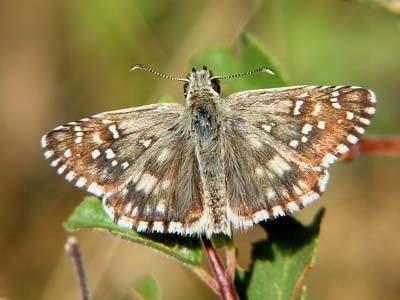Family Hesperiidae Scientific name Pyrgus armoricanus | Genus Pyrgus Rank Species | |
 | ||
Similar Large grizzled skipper, Olive skipper, Grizzled skippers, Spialia sertorius, Safflower skipper | ||
Oberth r s grizzled skipper pyrgus armoricanus soumra n k podobn
Oberthür's grizzled skipper (Pyrgus armoricanus) is a species of skipper (family Hesperiidae). The species is named after the French entomologist Charles Oberthür (1845–1924) who originally described it.
Contents
- Oberth r s grizzled skipper pyrgus armoricanus soumra n k podobn
- Oberth r s grizzled skipper pyrgus armoricanus x 2
- Subspecies
- Distribution and habitat
- Description
- Biology
- References
Oberth r s grizzled skipper pyrgus armoricanus x 2
Subspecies
Subspecies include:
Distribution and habitat
This species can be found throughout Europe although it is commoner in the south and absent from the British Isles and most of Scandinavia. It is also present in Northwest Africa. These butterflies mainly inhabit hot grassy flowery meadows and in dry, rocky and herbaceous forests, at an elevation of 0–1,800 metres (0–5,906 ft) above sea level.
Description
Pyrgus armoricanus has a wingspan of 24–28 mm. Both wings have a white fringe along the edges. The upperside of the forewings is dark brown with well developed white markings. On the recto of the hindwings there are clearly visible grayish marks. The underside of the hindwings shows a pale reddish-brown colour with a large pale discal spot and light coloured veins. The males and females are similar in appearance.
Like all Pyrgus species, it can be very difficult to identify in the field. The upperside of the forewings are often noticeably darker brown than other Pyrgus species, especially when fresh, with clear white markings. It resembles some smaller races of large grizzled skipper (P. alveus). It is slightly larger than Pyrgus malvae.
This species is quite similar to Pyrgus carthami, Pyrgus alveus, Pyrgus serratulae and Pyrgus malvae.
The eggs are yellowish, roundish and flattened, with numerous, strong longitudinal ribs. The caterpillars have strong short hairs. They are mostly dark brown to gray-brown, rarely greenish brown or reddish-brown with a black head. Pupae are strongly bluish-frosted with black dots and dashes on the back.
Biology
P. armoricanus flies in May and June with a second generation in the south of the range in August and September. Adults of this second generation are usually smaller than those of the first. The females lay their eggs individually on the underside of the leaves of host plants.
In most of Europe the larva feeds on Potentilla species (Potentilla tabernaemontani, Potentilla reptans, Potentilla arenaria, Potentilla pedata) and woodland strawberry (Fragaria vesca). In southern Scandinavia (Sweden and Denmark), however, the main larval food plant is Filipendula vulgaris and to some extent also Helianthemum nummularium. The caterpillar overwinters.
